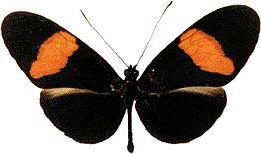Linkage equilibrium

Linkage equilibrium describes the situation in which the haplotype frequencies in a population have the same value that they would have if the genes at each locus were combined at random. In other words, it occurs when linkage disequilibrium is at zero.
Linkage equilibrium can be thought of as the two locus version of the Hardy-Weinberg ratio, but it is a property of haplotypes, not genotypes. A diploid individual has two haplotypes, and at the equilibrium the genotypes at each locus will be in Hardy-Weinberg proportions while the haplotypes are at linkage equilibrium.
Like the Hardy-Weinberg ratio, it is an equilibrium because in the absence of selection and with random mating the action of recombination over time will drive the haplotypes to random frequencies and then keep them there.
The Heliconius erato species of butterfly (opposite) provide a good example of linkage equilibrium in the genes that control their wing color.
The geneticist Linda Partridge explains the concepts of linkage equilibrium and disequilibrium.
How do we calculate linkage equilibrium?
| Next |



